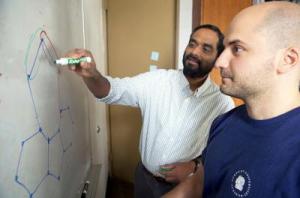Nov 12 2010
The website of the Nobel Prize shows a cat resting in a graphene hammock. Although fictitious, the image captures the excitement around graphene, which, at one atom thick, is the among the thinnest and strongest materials ever produced.
A significant obstacle to realizing graphene's potential lies in creating a surface large enough to support a theoretical sleeping cat. For now, material scientists stitch individual graphene sheets together to create sheets that are large enough to investigate possible applications. Just as sewing patches of fabric together may create weaknesses where individual patches meet, defects can weaken the "grain boundaries" where graphene sheets are stitched together — at least that is what engineers had thought.
 Engineers had thought that sheet of graphene that are joined together would have weakneses at the point of attachment. In some cases, however, the area where two sheets of graphene are joined can be as strong as pure graphene. Vivek Shenoy, with graduate student Rassin Grantab, illustrates the carbon heptagons that mark these “grain boundaries.”
Engineers had thought that sheet of graphene that are joined together would have weakneses at the point of attachment. In some cases, however, the area where two sheets of graphene are joined can be as strong as pure graphene. Vivek Shenoy, with graduate student Rassin Grantab, illustrates the carbon heptagons that mark these “grain boundaries.”
Now, engineers at Brown University and the University of Texas–Austin have discovered that the grain boundaries do not compromise the material's strength. The grain boundaries are so strong, in fact, that the sheets are nearly as strong as pure graphene. The trick, they write in a paper published in Science, lies in the angles at which the individual sheets are stitched together.
"When you have more defects, you expect the strength to be compromised," said Vivek Shenoy, professor of engineering and the paper's corresponding author, "but here it is just the opposite."
The finding may propel development of larger graphene sheets for use in electronics, optics and other industries.
Graphene is a two-dimensional surface composed of strongly bonded carbon atoms in a nearly error-free order. The basic unit of this lattice pattern consists of six carbon atoms joined together chemically. When a graphene sheet is joined with another graphene sheet, some of those six-carbon hexagons become seven-carbon bonds — heptagons. The spots where heptagons occur are called "critical bonds."
The critical bonds, located along the grain boundaries, had been considered the weak links in the material. But when Shenoy and Rassin Grantab, a fifth-year graduate student, analyzed how much strength is lost at the grain boundaries, they learned something different.
"It turns out that these grain boundaries can, in some cases, be as strong as pure graphene," Shenoy said.
The engineers then set out to learn why. Using atomistic calculations, they discovered that tilting the angle at which the sheets meet — the grain boundaries — influenced the material's overall strength. The optimal orientation producing the strongest sheets, they report, is 28.7 degrees for sheets with an armchair pattern and 21.7 degrees for sheets with a zigzag layout. These are called large-angle grain boundaries.
Large-angle grain boundaries are stronger because the bonds in the heptagons are closer in length to the bonds naturally found in graphene. That means in large-angle grain boundaries, the bonds in the heptagons are less strained, which helps explain why the material is nearly as strong as pure graphene despite the defects, Shenoy said.
"It's the way the defects are arranged," Shenoy said. "The grain boundary can accommodate the heptagons better. They're more relaxed."
Source: http://news.brown.edu/